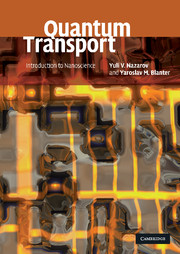Book contents
- Frontmatter
- Contents
- Preface
- Introduction
- 1 Scattering
- 2 Classical and semiclassical transport
- 3 Coulomb blockade
- 4 Randomness and interference
- 5 Qubits and quantum dots
- 6 Interaction, relaxation, and decoherence
- Appendix A Survival kit for advanced quantum mechanics
- Appendix B Survival kit for superconductivity
- Appendix C Unit conversion
- References
- Index
3 - Coulomb blockade
Published online by Cambridge University Press: 05 June 2012
- Frontmatter
- Contents
- Preface
- Introduction
- 1 Scattering
- 2 Classical and semiclassical transport
- 3 Coulomb blockade
- 4 Randomness and interference
- 5 Qubits and quantum dots
- 6 Interaction, relaxation, and decoherence
- Appendix A Survival kit for advanced quantum mechanics
- Appendix B Survival kit for superconductivity
- Appendix C Unit conversion
- References
- Index
Summary
A paradox of solid state physics is that electrons in conductors are almost exclusively regarded as non-interacting particles, even though they do interact. This comes both from physical reasons and from the human need for convenience. The physical reason is that the interacting electrons form a ground state, and charged elementary excitations above the state – quasielectrons – do not interact provided their energies are sufficiently close to the Fermi surface. This makes a model of non-interacting electrons completely adequate for quasielectrons, at least in the low-energy limit. This allows a scattering approach to quantum transport that assumes the absence of interaction. The convenience model is that the physics of non-interacting particles is much easier to understand and apply. Besides, sticking to a convenient picture usually goes unpunished. In fact, in solid state physics there are only a few rather exotic examples where interaction effects really reign and the noninteracting approach produces obviously erroneous results. These cases are notoriously difficult to comprehend and to quantify; some effects revealed almost a century ago (for instance, Mott insulator transition) are still on the front-line of modern research.
In contrast to solid state physics, there is a very common regime in quantum transport where interaction effects are dominant: the Coulomb blockade regime, and here the scattering approach fails. However, in contrast to the situation in solid state systems, Coulomb blockade systems are usually even simpler than those of Chapters 1 and 2 where interaction does not play an important role. Due to this, one can quickly grasp the fascinating features of Coulomb blockade physics, and begin to design and apply Coulomb blockade circuits and devices.
- Type
- Chapter
- Information
- Quantum TransportIntroduction to Nanoscience, pp. 211 - 298Publisher: Cambridge University PressPrint publication year: 2009



